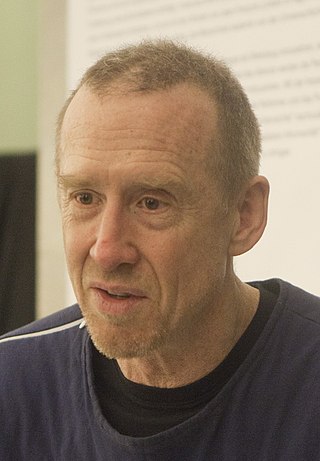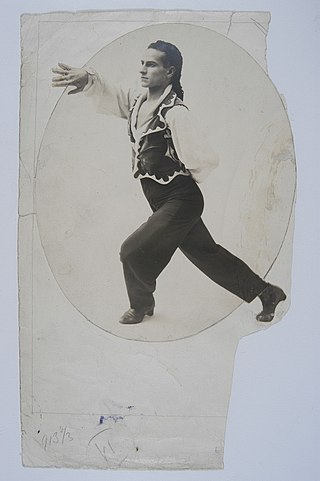Related Research Articles

Ballet is a type of performance dance that originated during the Italian Renaissance in the fifteenth century and later developed into a concert dance form in France and Russia. It has since become a widespread and highly technical form of dance with its own vocabulary. Ballet has been influential globally and has defined the foundational techniques which are used in many other dance genres and cultures. Various schools around the world have incorporated their own cultures. As a result, ballet has evolved in distinct ways.

George Balanchine was an American ballet choreographer of Georgian origin, recognized as one of the most influential choreographers of the 20th-century. Styled as the father of American ballet, he co-founded the New York City Ballet and remained its artistic director for more than 35 years. His choreography is characterized by plotless ballets with minimal costume and décor, performed to classical and neoclassical music.

New York City Ballet (NYCB) is a ballet company founded in 1948 by choreographer George Balanchine and Lincoln Kirstein. Balanchine and Jerome Robbins are considered the founding choreographers of the company. Léon Barzin was the company's first music director. City Ballet grew out of earlier troupes: the Producing Company of the School of American Ballet, 1934; the American Ballet, 1935, and Ballet Caravan, 1936, which merged into American Ballet Caravan, 1941; and directly from the Ballet Society, 1946.

William Forsythe is an American dancer and choreographer formerly resident in Frankfurt am Main, Germany, and now based in Vermont. He is known for his work with the Ballet Frankfurt (1984–2004) and The Forsythe Company (2005–2015). Recognized for the integration of ballet and visual arts, which displayed both abstraction and forceful theatricality, his vision of choreography as an organizational practice has inspired him to produce numerous installations, films, and web-based knowledge creation, incorporating the spoken word and experimental music.

Violette Verdy was a French ballerina, choreographer, teacher, and writer who worked as a dance company director with the Paris Opera Ballet in France and the Boston Ballet in the United States. From 1958 to 1977 she was a principal dancer with the New York City Ballet where she performed in the world premieres of several works created specifically for her by choreographers George Balanchine and Jerome Robbins. She was Distinguished Professor of Music (Ballet) at the Jacobs School of Music, Indiana University, in Bloomington, and the recipient of two medals from the French government.
André Yacovlev Levinson, Андрей (Андрэ) Яковлевич Левинсон [Andrey Yakovl'evich Levinson], November 1, 1887, St. Petersburg - December 3, 1933, Paris) was, after leaving Russia in 1918, a French dance journalist. He was awarded the Ordre national de la Légion d'honneur.
Eliot Feld is an American modern ballet choreographer, performer, teacher, and director. Feld works in contemporary ballet. His company and schools, including the Feld Ballet and Ballet Tech, are involved in dance and dance education in New York City.

Steven Douglas Paxton was an American experimental dancer and choreographer. His early background was in gymnastics while his later training included three years with Merce Cunningham and a year with José Limón. As a founding member of the Judson Dance Theater, he performed works by Yvonne Rainer and Trisha Brown. He was a founding member of the experimental group Grand Union and in 1972 named and began to develop the dance form known as Contact Improvisation, a form of dance that utilizes the physical laws of friction, momentum, gravity, and inertia to explore the relationship between dancers.
Le Tombeau de Couperin is a ballet choreographed by George Balanchine to Ravel's eponymous orchestral music. The ballet features a cast of sixteen divided into two groups, dancing separately. Le Tombeau de Couperin was made for the New York City Ballet's Ravel Festival, celebrating the composer's centenary, and premiered on May 29, 1975, at the New York State Theater.

Episodes is a ballet choreographed by Martha Graham and George Balanchine, to compositions by Anton Webern. The ballet was a co-production between the Martha Graham Dance Company and Balanchine's New York City Ballet (NYCB). Though it was conceived to be a collaboration between Graham and Balanchine, leading choreographers in modern dance and neoclassical ballet respectively, they ultimately worked separately on the ballet's two halves. Episodes I was choreographed by Graham, for dancers from her company and four NYCB members, and depicts Mary, Queen of Scots remembering the events in her life before her execution. Episodes II, by Balanchine, is completely plotless, and made for members of the NYCB and Graham dancer Paul Taylor, who originated a solo. The ballet uses all seven orchestral compositions by Webern.

Who Cares? is a ballet choreographed by George Balanchine to songs by George Gershwin that were orchestrated by Hershy Kay. The ballet is split in two parts, the first danced by an ensemble, and the second focuses on four principal dancers. Who Cares? premiered on February 5, 1970, at the New York State Theater, danced by the New York City Ballet.
Ivesiana is a ballet choreographed by George Balanchine to compositions by Charles Ives. The ballet premiered on September 14, 1954, four months after Ives's death, at the City Center of Music and Drama, performed by the New York City Ballet. Balanchine made several changes to the ballet since, including adding and removing sections of the ballet, and the final version of Ivesiana consists of Central Park in the Dark, The Unanswered Question, In the Inn and In the Night.

Concerto Barocco is a neoclassical ballet choreographed by George Balanchine to Bach's Concerto for Two Violins. Danced by a cast of eleven, the ballet is completely plotless, and according to Balanchine, "has no "subject matter" beyond the score which it is danced and the particular dancers who execute it". The ballet was made for the American Ballet Caravan's 1941 South American tour, and premiered on June 27, 1941, at Teatro Municipal, Rio de Janeiro. The ballet has entered the repertories of many ballet companies, including Balanchine's New York City Ballet.
Scotch Symphony is a ballet choreographed by George Balanchine to Mendelssohn's Symphony No. 3, "Scottish". The ballet is inspired by Scotland, and evokes the style of the romantic ballet era, particularly La Sylphide, which is set in Scotland. Scotch Symphony was made for the New York City Ballet, and premiered on November 11, 1952, at the City Center of Music and Drama.

Olga Elise Reiman was an American ballet dancer and dance educator. After starting her career working with choreographer Adolph Bolm, she danced at the American Ballet and Ballet Society, both forerunners of the New York City Ballet, and originated several roles for choreographer George Balanchine. Reiman taught at Balanchine's School of American Ballet between 1945 and 1953 and from 1964 until her death.
Balanchine technique or Balanchine method is the ballet performance style invented by dancer, choreographer, and teacher George Balanchine (1904–1983), and a trademark of the George Balanchine Foundation. It is used widely today in many of Balanchine's choreographic works. It is employed by ballet companies and taught in schools throughout North America, including the New York City Ballet and School of American Ballet, where it first emerged.
Paul Boos is an American dancer, ballet master, archivist, and répétiteur. He danced with New York City Ballet from 1977 until 1990 before becoming a guest teacher for the Royal Danish Ballet. In addition to teaching internationally, he is part of a select group of répétiteurs sanctioned by the Balanchine Trust to set the ballets of George Balanchine. Having previously served as Project Associate since 2016, in 2021, Boos was appointed to Director of the Video Archives for the George Balanchine Foundation.

Leon Woizikovsky, originally Léon Wójcikowski was a Polish dancer and ballet master, and later choreographer and teacher. He first came to prominence as a member of the Ballets Russes. Later he worked with various ballet companies, e.g., Pavlova, de Basil, de Valois, Ballet Polonaise, Massine, the London Festival, the Royal Flemish.
Jennifer A. Homans is an American historian, author, and dance critic. Her book Apollo's Angels: A History of Ballet was a finalist for the National Book Critics Circle Award in 2010.
Divertimento No. 15 is a ballet choreographed by George Balanchine to Mozart's eponymous music. The ballet was made for the New York City Ballet. Balanchine first choreographed the score in 1952, for a ballet titled Caracole. In 1956, he planned to revive Caracole for a celebration of Mozart's bicentenary but made a new ballet to the same music instead. Divertimento No. 15 premiered on May 31, 1956, at the American Shakespeare Theatre, Stratford, Connecticut.
References
- ↑ Acocella, Joan (2017-05-05). "Preserving George Balanchine's Vulnerable Ballets". The New Yorker. ISSN 0028-792X . Retrieved 2023-06-30.
- ↑ "Dance Historian to Be Honored". The New York Times . 9 September 2013. Retrieved 16 January 2016.
- ↑ "Balanchine the Way Balanchine Intended It". The New York Times. 11 August 1996. Retrieved 16 January 2016.
- ↑ Berg, Shelley C. (Summer 2005). "Reviewed Work: No Fixed Points: Dance in the Twentieth Century by Nancy Reynolds, Malcolm McCormick". Dance Research Journal . 37 (1). JSTOR 20444628.